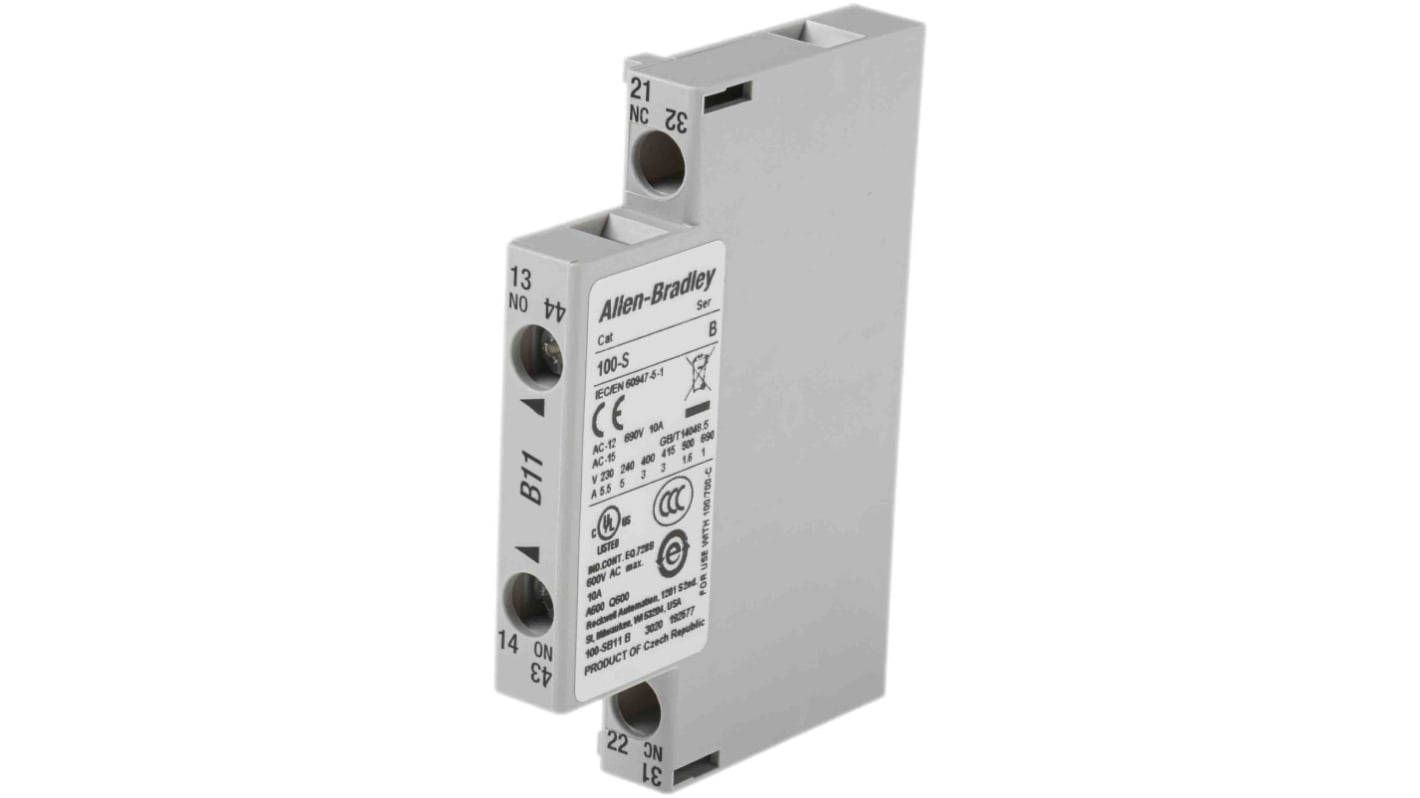Allen Bradley Auxiliary Contact, 2 Contact, 1NC + 1NO, Side Mount 100S
- RS Stock No.:
- 238-1121
- Mfr. Part No.:
- 100-SB11
- Brand:
- Allen Bradley

Subtotal (1 unit)*
£12.94
(exc. VAT)
£15.53
(inc. VAT)
FREE delivery for orders over £50.00
In Stock
- 20 unit(s) ready to ship
- Plus 37 unit(s) ready to ship from another location
- Plus 70 unit(s) shipping from 02 February 2026
Need more? Click ‘Check delivery dates’ to find extra stock and lead times.
Units | Per unit |
|---|---|
| 1 + | £12.94 |
*price indicative
- RS Stock No.:
- 238-1121
- Mfr. Part No.:
- 100-SB11
- Brand:
- Allen Bradley
Specifications
Technical Reference
Legislation and Compliance
Product Details
Find similar products by selecting one or more attributes.
Select all | Attribute | Value |
|---|---|---|
| Brand | Allen Bradley | |
| Number of Contacts | 2 | |
| Normal State Configuration | 1NC + 1NO | |
| Mounting Style | Side Mount | |
| Series | 100S | |
| Contact Current Rating | 10 A | |
| Terminal Type | Screw | |
| Pole and Throw Configuration | SPST | |
| Select all | ||
|---|---|---|
Brand Allen Bradley | ||
Number of Contacts 2 | ||
Normal State Configuration 1NC + 1NO | ||
Mounting Style Side Mount | ||
Series 100S | ||
Contact Current Rating 10 A | ||
Terminal Type Screw | ||
Pole and Throw Configuration SPST | ||
RoHS Status: Exempt
- COO (Country of Origin):
- GB
MCS Auxiliary Contact Modules
10A rated (AC1)
Blocks per contactor 2 side + 1 top (max. 8 contacts)
Min. switching 17V 5mA (DIN 19240)
Blocks per contactor 2 side + 1 top (max. 8 contacts)
Min. switching 17V 5mA (DIN 19240)
Maintain high levels of reliability in industrial process-control applications with this Allen Bradley auxiliary contact from Rockwell Automation. It can be fitted to protection and control devices such as relays and circuit breakers to signal switching or malfunction states. The compact unit is fixed directly into a main contact, so it doesn't take up much space. Dual numbering on both sides of the device gives you a choice of mounting on the left or right side of a contactor for enhanced versatility.
• Screw terminals for simple installation and a reliable join
• Recyclable at end of life for a reduced carbon footprint
• Electronically compatible contacts to reduce the risk of machine downtime
• Safe positive guidance to prevent all poles from being closed at the same time
• Recyclable at end of life for a reduced carbon footprint
• Electronically compatible contacts to reduce the risk of machine downtime
• Safe positive guidance to prevent all poles from being closed at the same time
Standards and Certifications
• IEC 947-5-1 (International Electrotechnical Commission)
• DIN 19240 (Deutsches Institut für Normung)
• DIN 19240 (Deutsches Institut für Normung)
How does an auxiliary contact work?
An auxiliary contact changes state when the main contact does. It transfers data from an electrical circuit to a logic controller, which in turn gives instructions to the linked devices about whether to turn on or off. You can also use it as a stand-alone hardware control unit.
